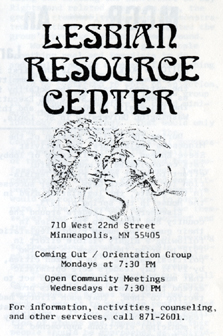Lesbian Resource Center
710 West 22nd Street, Minneapolis, MN
| An advertisement for the LRC in the 1974 Twin Cities Pride Guide. Courtesy of the Jean-Nickolaus Tretter Collection. |
“Gay Woman in the Minneapolis/St. Paul area have opened a Lesbian Resource Center in Minneapolis to better serve the needs of lesbians. We have found that other organizations are either too male or straight-oriented, leaving us with a sense of invisibility. We are now coming out completely, affirming we are here…”
|
The LRC was a catalyst of pioneering organizations in Minneapolis; a collection of books from the Brown House commune became Amazon Feminist/True Colors Bookstore at this site, and the Lavender Cellar Theater, a lesbian theater group that formed before At the Foot of the Mountain Theater Company, used the space for their first performances in 1973. A Woman's Coffeehouse also used the space before relocating to the Plymouth Congregational Church.
The collectively-run organization—like others in the young GLBT community—was rife with infighting and scandal. It appealed to a radical and politically active group of (predominantly young) lesbian women; some found the community center “a very depressing place, couches with springs coming out, it just had a terrible feeling…” These negative qualities only dampened the organization slightly. Overwhelmingly, it was a place where many lesbian women discovered their identities and made lasting friendships.
This page is still under construction. -SVC
Part of Minneapolis/St. Paul, MN: 100 Queer Places in Minnesota History, (1860-1969), (1969-2010)
